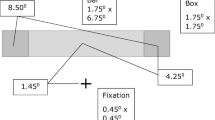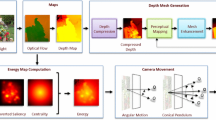Abstract
An experiment was conducted in which the effectiveness of three line-up methods (live, video, and photographs) was compared. Participants witnessed a staged event and were subsequently required, by one of the three methods, to identify the target. Both target-present and target-absent line-ups were used. The results showed that all methods led to an equal number of correct identifications (hits). In the target-absent line-ups, participants more often incorrectly identified a person in the video and photographs condition than in the live condition. Presenting photographs simultaneously or sequentially did not affect the number of correct judgments. Dynamic video images, showing locomotion and facial expression, had a marginal significant effect on the number of correct judgments as compared with the static video images. Practical implications are discussed.
Similar content being viewed by others
References
Bothwell, R.K., Brigham J.C., & Deffenbacher, K.A. (1987). Correlation of eyewitness accuracy and confidence: optimality hypothesis revisited.Journal of Applied Psychology, 72, 691–695.
Cutler, B.L., Berman, G.L., Penrod, S., & Fisher, R.P. (1994). Conceptual, practical, and empirical issues associated with eyewitness identification test media. In D.F. Ross, J.D. Read and M.D. Toglia (eds.):Adult eyewitness testing: current trends and developments. New York: Cambridge University Press.
Cutler, B.L., & Fisher, R.P. (1990). Live line-ups, videotaped line-ups, and photoarrays.Forensic Reports, 2, 93–106.
Cutler, B.L., Fisher, R.P., & Chicvara, C.L. (1989). Eyewitness identification from live versus videotaped line-ups.Forensic Reports, 2, 93–106.
Cutler, B.L., Fisher, R.P., & Chicvara, C.L. (1989). Eyewitness identification from live versus videotaped line-ups.Forensic Reports, 2, 93–106.
Cutler, B.L., & Penrod, S.D. (1988). Improving the reliability of eyewitness identification: line-up construction and presentation.Journal of Applied Psychology, 73, 281–290.
Cutler, B.L., Penrod, S.D., & Martens, T.K. (1987). Improving the reliability of eyewitness identification: putting context into context.Journal of Applied Psychology, 72, 629–637.
Dent, H.R. (1977). Stress as a factor influencing person recognition in identification parades.Bulletin of British Psychology, 30, 339–340.
Dunning, D., & Stern, L.B. (1994). Distinguishing accurate from inaccurate eyewitness identifications via inquiries about decision processes.Journal of Personality and Social Psychology, 67, 818–835.
Edwards, K. (1998). The face of time: Temporal cues in facial expressions of emotions.Psychological Science, 9, 270–276.
Kerstholt, J.H., Raaijmakers, J.G.W., & Valeton, J.M. (1992). The effect of expectation on the identification of known and unknown persons.Applied Cognitive Psychology, 6, 173–180.
Lindsay, R.C.L., & Wells, G.L. (1985). Improving eyewitness identifications from line-ups: simultaneous versus sequential line-up presentation.Journal of Applied Psychology, 70, 556–564.
O'Rourke, T.E., Penrod, S.D., Cutler, B.L. & Stuve, T.E. (1989). The external validity of eyewitness identification research: Generalizing across subject populations.Law and Human Behavior, 13, 385–395.
Shapiro, P.N., & Penrod, S. (1986). Meta-analysis of facial identification studies.Psychological Bulletin, 100, 139–156.
Sporer, S.L. (1993). Eyewitness identification accuracy, confidence, and decision times in simultaneous and sequential line-ups.Journal of Applied Psychology, 78, 22–33.
Sporer, S.L., Penrod, S., Read, D., & Cutler, B. (1995). Choosing, confidence and accuracy: a meta-analysis of the confidence-accuracy relation in eyewitness identification studies.Psychological Bulletin, 118, 315–327.
Wagenaar, W.A. (1969). Note on the construction of digram-balanced latin squares.Psychological Bulletin, 72, 384–386.
Author information
Authors and Affiliations
Corresponding author
Rights and permissions
About this article
Cite this article
Kerstholt, J.H., Koster, E.R. & van Amelsvoort, A.G. Eyewitnesses: A comparison of live, video, and photo line-ups. J Police Crim Psych 19, 15–22 (2004). https://doi.org/10.1007/BF02813869
Issue Date:
DOI: https://doi.org/10.1007/BF02813869




